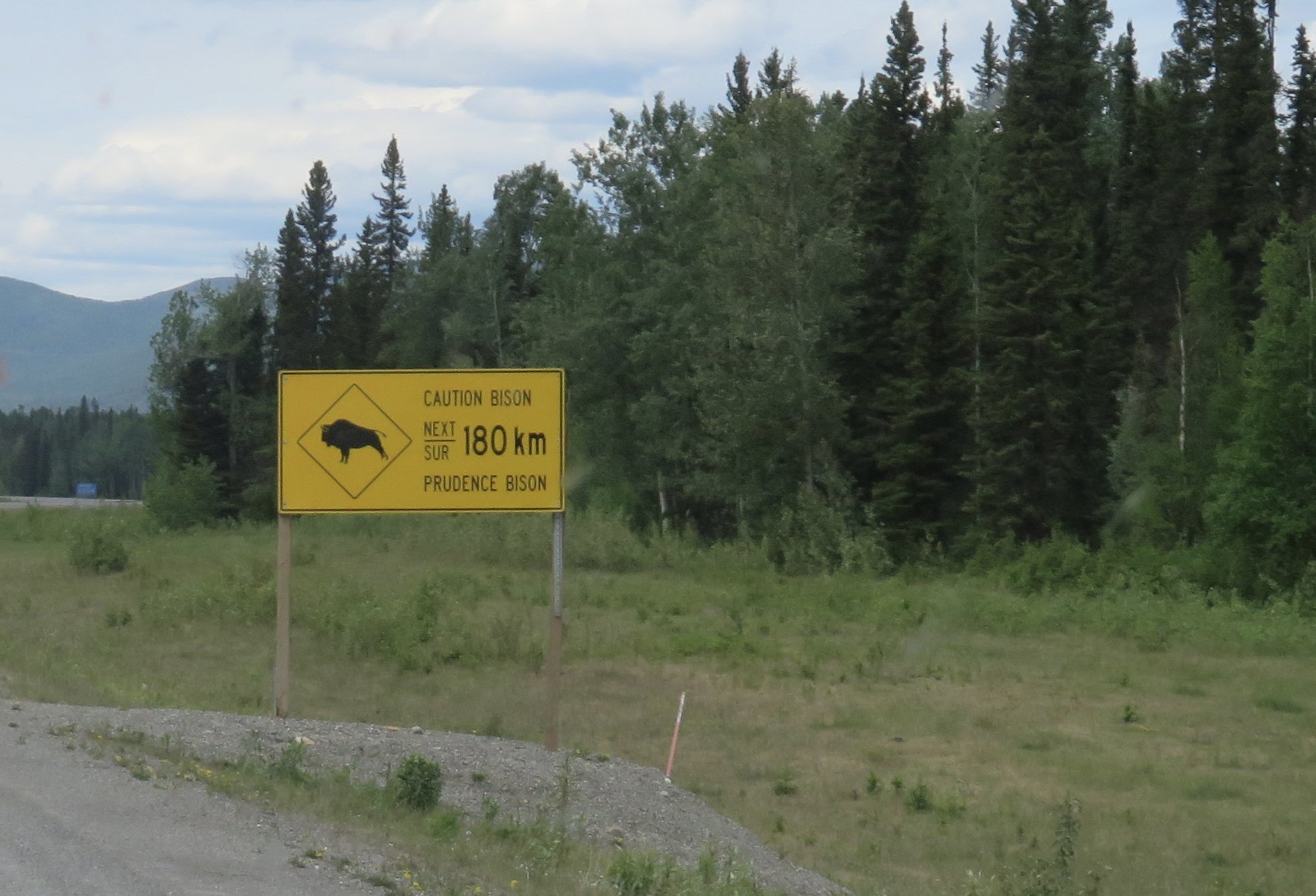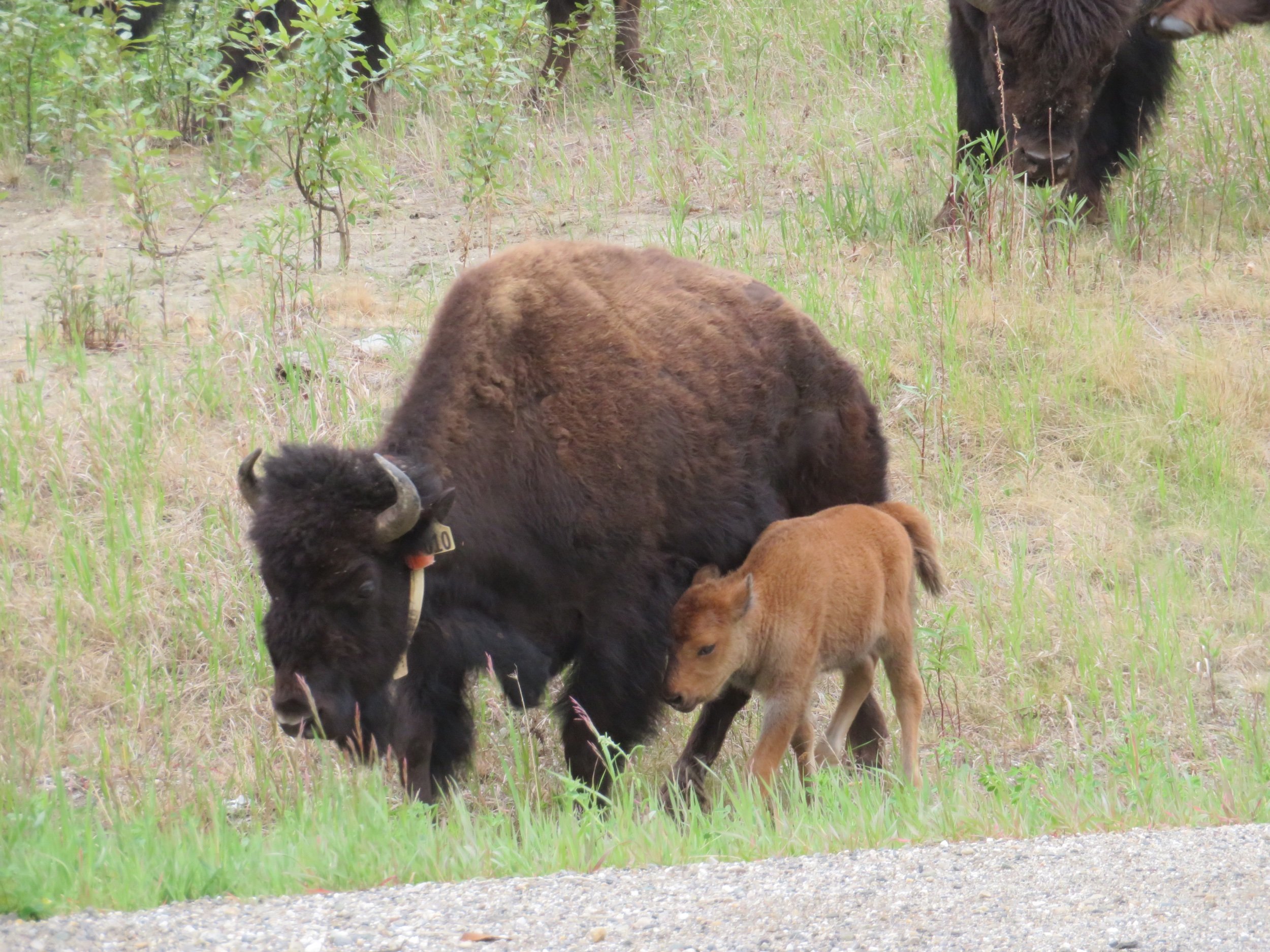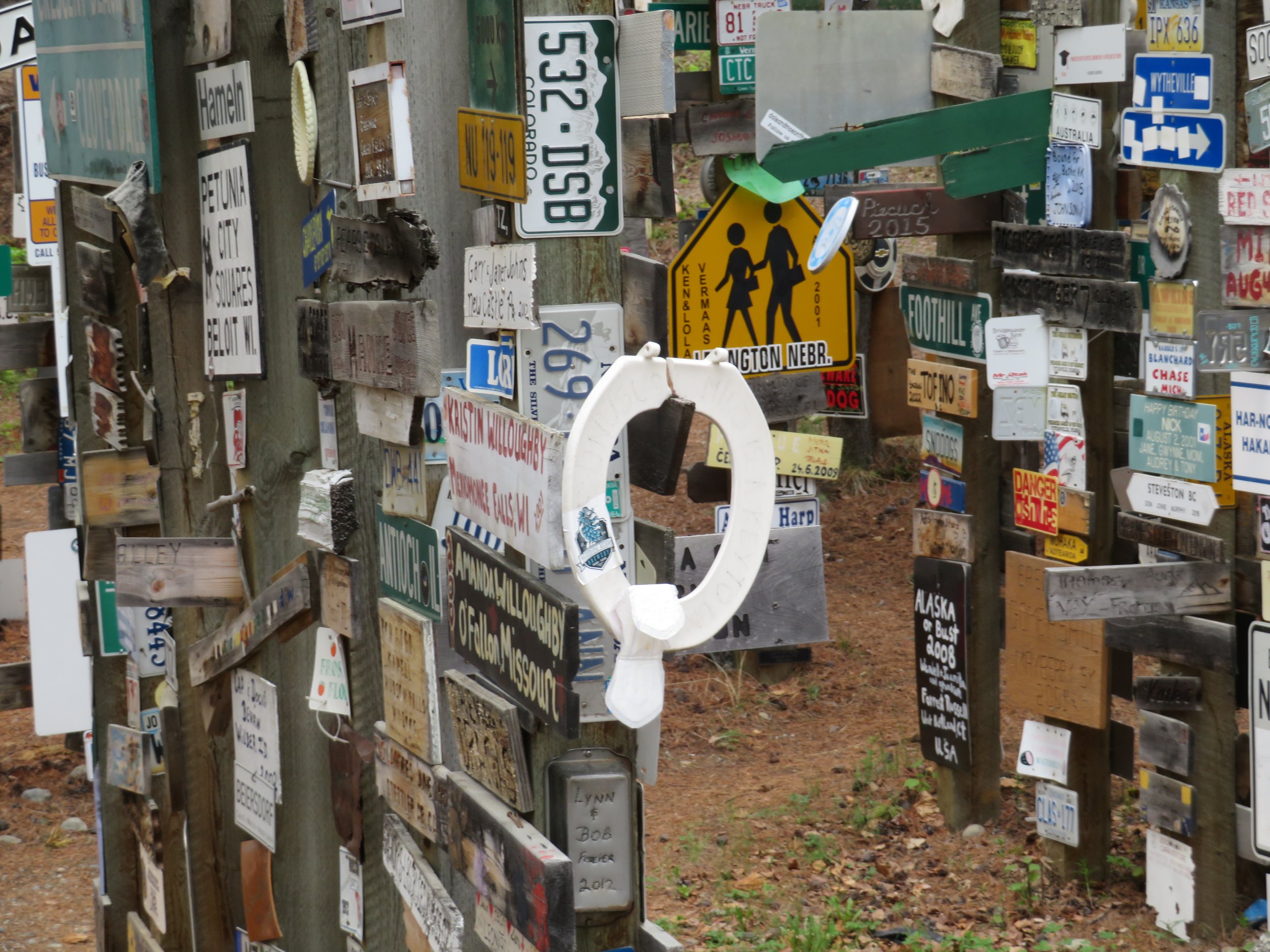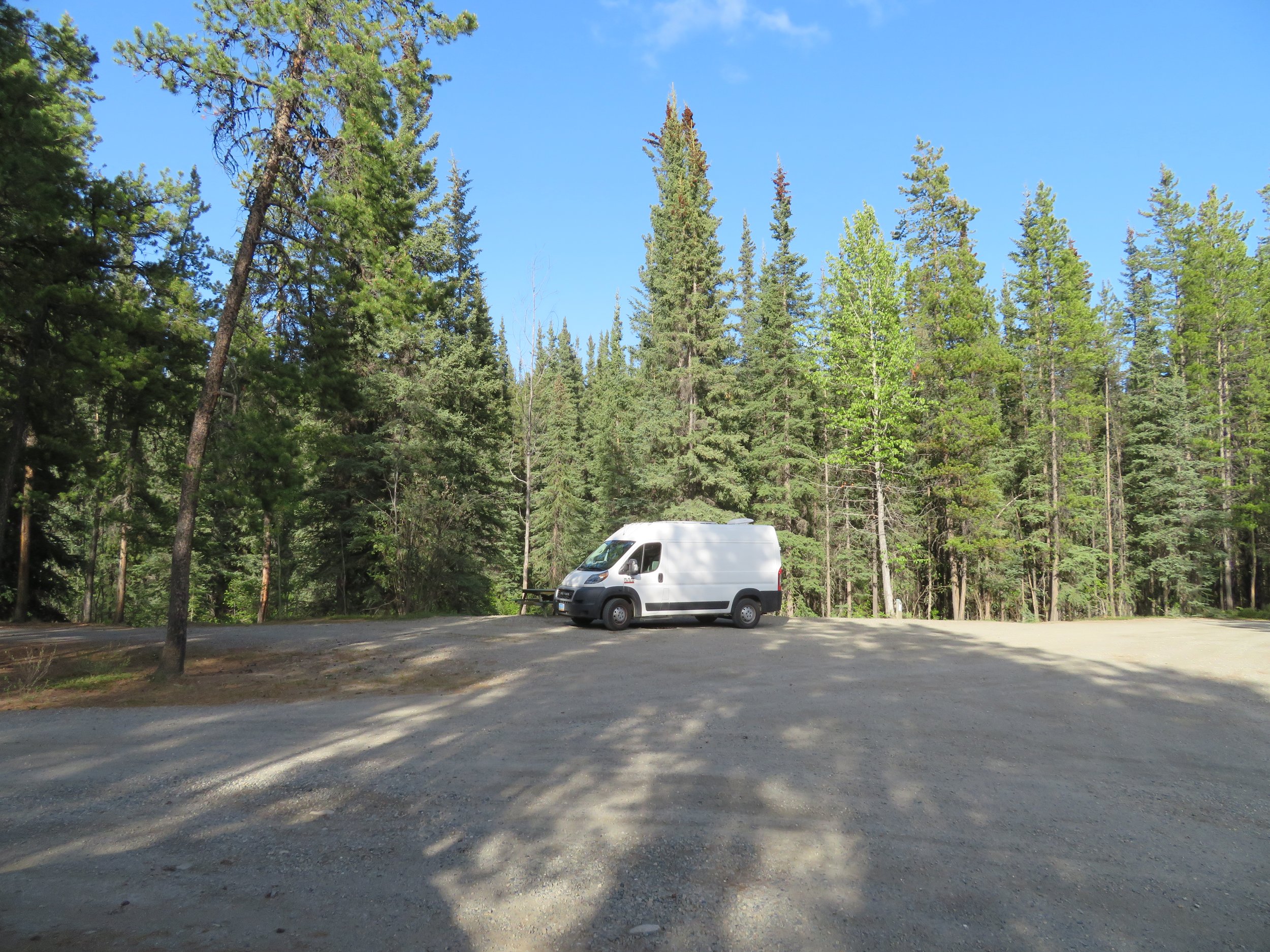Alaska Highway - Liard Hot Springs to Whitehorse
/It’s still ‘dusky’ light at 11pm and it’s easy to stay up late and regret it in the morning. In fact, it’s hard to tell morning from any other time of day other than looking at a clock. This ‘morning’ was overcast with smoke and clouds and we were surprised when we woke and the clock read 0730. Yikes! Half the day is gone! Since there was no Wi-Fi and thus no morning newspaper, we saved an hour getting on the road and we were on the move by 0900.
Beyond the hot springs, Liard is noted as being an area frequented by the resident wandering wood bison herd. Several folks had seen bison already and we were feeling a bit disappointed that we hadn’t. Bison are a threatened species and this particular herd lives year round on the Alaska Highway… literally, ON the Alaska Highway. They graze there, sleep there and hang out there. All sorts of warnings are posted to proceed with caution since a collision with a 2000-lb bison could be catastrophic for both parties.
We hadn’t gone more than 10 miles from the campground when starting seeing buffalo chips in the middle of the road. Within a mile we met up with several members of the herd… all over the side and middle of highway… and they just kept coming. We stopped and watched as they wandered by, calling and snorting to each other, munching as they went, pretty much oblivious to us. We counted 62.
We noted that some were collared and we wondered how and who managed to collar them. We drove another 30 miles and spotted 9 more shaggy adult bison.
We saw the ‘Welcome to Yukon’ sign and stopped at MM385 so David could straddle the provincial line.
BC-97 (the Alaska Highway) in British Columbia changes to YT-1 as it crosses the province line into Yukon Territory - and it dips back and forth between provinces six times before staying in the Yukon.
Crossing the 60th parallel (60° North) was marked with a small sign and just beyond, we spotted our first caribou.
It was cold and blustery when we arrived in Watson Lake, dubbed the “Gateway to the Yukon”.` We checked out the Visitor’s Centre… what a place. It’s large with enthusiastic, extremely helpful agents offering a huge range of brochures, maps and information. Toilets (free) and showers ($6.50) are both available in the building.
Then we checked out the Signpost Forest… yikes… it was absolutely huge with a purportedly 100,000+ signposts and it continues to grow.
The story goes that in 1942, a soldier working on the Alaska Highway was tasked with making, repairing and erecting directional mileage signs. Feeling a bit homesick, he included a sign for his hometown of Danville, Illinois. The rest is history. The Sign Forest was designated a Yukon Historic Site in 2013.
David had not yet finished our sign and was feeling a bit verklempt about it. After wandering through the forest and seeing makeshift signs ranging from beautifully carved and lacquered wooden nameplates to toilet seats, frying pans and various other materials, we decided we could modify our sign plans just a bit. The kitchen bin sacrificed a yellow plastic plate and once David finished the lettering, he affixed it a tree with the other 100,000+ that were there.
We’d seen signs and read about the Northern Lights Planetarium and since our chances of actually seeing the northern lights in summer are nil, we decided we’d check out the shows… Sun Storms and the Aurora Borealis. Only one other couple was in the theatre/planetarium with us and the presentations were excellent. Glad we went. I’ve never seen the Northern Lights and I’d love to. Can you imagine camping out and have this display dance in the sky above you?
We needed a bit of exercise and the Visitor Centre directed us to Wye Lake Park for a 1.5+ mile interpretive-signed easy walk around the lake. It was after 3pm and we wondered briefly if it was too late to start a walk and then remembered, we had at least 8-9 more hours of light. Duh!
The boggy parts of the lake had wooden boardwalks lined with willows which connected to dirt and crushed stone trails. It was good to get out and stretch. The willows were all furry, like the pussy willows we used to collect as kids, but much larger. We also saw delicate fairy slippers, bright blue Pretty Jacob’s Ladder, and purple Arctic lupine.
We took advantage of the Sani-dump at the park. This is the practical, not always pleasant part of camping and having to ‘dump’ the pee and waste that’s been accumulating is a necessary evil. So far, we’ve found that several towns have designated ‘sani-dumps’ that are free, easily accessed and convenient. A big positive when you’re in a camper, van, or an RV.
Very similar to cruising, we keep meeting the same people over and over again. We’re all on similar routes and we start recognizing each other, sharing information and stories and animal sightings. We met one couple in Fort Nelson, Helen and Gerald from Ontario, and we’ve now seen them several times and joke about who’s following or leading whom.
David had read about the Watson Lake Airport which had been a major stop on the Northwest Staging Route during WWII. It was only a couple of miles out of town so we headed out there.
The old B.C.-Yukon Air Service Ltd. Hangar was constructed when larger and improved facilities were needed to repair and fuel U.S. war planes en route to Alaska where Allied Russian pilots met them and flew them over Siberia to the Russian front lines. My… how times and players have changed. It is the last military hangar of its type in Canada.
Near the entrance to the airport is a cairn and a four-bladed bent propeller which was taken from the Avro Lincoln Bomber that crashed in in 1948 in Watson Lake. Three servicemen were killed at Watson Lake during their tour of duty. The memorials are dedicated to “the ground crews and pilots who flew the Northwest Staging Route and participated in the Winter Experimental Establishment between 1941 and 1957.”
We hadn’t made any campground plans for Watson Lake and since we were still feeling fine, we decided to drive a bit further to the Big Creek Territorial Campground.The campsite was lovely beside the Big Creek and included free firewood, vault toilets, a fire ring and picnic table for $20/night. The water from the water pump was ‘iffy’ and we used our own fresh water.
It was cold, cold, cold during the night 32F (0°C) and only 45F inside Blanche when we got up in the morning. Even with the diesel heater to take off some of the chill, we didn’t waste any time getting on the road. By 0630 we could see the Ranchero Mountains in the distance. We were heading to Whitehorse, Yukon’s capital city today.
A thick blanket of fog covered the lake and road. It became thicker and thicker till we lost sight of the mountains in the distance and eventually lost sight of the road.
The dense fog persisted for miles and then we came to a mountain pass, crossed over the Continental Divide and the fog dissipated. As the fog cleared, the mountains views were stupendous.
We saw no critters today except ground squirrels and some roadkill (a fox, maybe?). The highway was lined with locoweed contrasting sharply with tufts of purple Arctic lupine and fuchsia pink boreal sweetvetch. Like BC, the Yukon has lots of turn outs and rest areas to stop and even spend the night at most places unless posted.
We had intended to stop at the Teslin Tlingit Heritage Center, but it was unexpectedly closed according to the sign on the door. We did get a chance to stretch our legs though and check out the totem poles.
As we returned to the highway, we spotted a red fox loping along the roadside. David stopped and backed up though we figured he’d have skedaddled by the time we were close enough for photos. Au contraire… this guy was a photographer’s dream. He struck pose after pose, showing off his beautiful white-tipped bushy tail. A very handsome fox, indeed!
Named by folks who thought the Yukon River white water rapids looked like white horses’ manes, the Welcome to Whitehorse sign greeted us as we entered the city limits. We’d done a little homework in advance and checked into the Hi-Country RV park (43.31/night including tax) for two nights. Hot showers were definitely in order and the dirty laundry was once again piling up. At ~$10/load to wash and dry, we planned to appreciate these clean clothes immensely. The sites were close together, but reasonable and the park was within 2-3 miles from downtown.
We visited the large, modern Visitors’ Centre which was well-stocked with brochures, maps and two knowledgeable women who provided lots of information. One woman directed us to the Waterfront Walkway, a pleasant walking path along the Yukon River which runs through downtown Whitehorse. As we viewed the river, we were reminded that our nephew, Erik and friends, had ridden their bicycles from Montana to Whitehorse, then loaded the bikes into a canoe and paddled up the Yukon to Dawson City, then completed their biking trip to Anchorage. Talk about adventures! Below… Yukon River view.
The SS Klondike is in dry dock here, the centerpiece of the National Historic Site dedicated to the amazing riverboat history in the Yukon. The park was closing when we arrived and more disappointing, the Klondike itself was closed to visitors for the entire 2023 summer season for needed repairs.
We retreated to our campsite and spent an enjoyable evening planning the next day and the rest of our route. Tomorrow was an errand day. Blanche needed an oil change. We needed to provision, do laundry and a long list of mundane chores. This little red squirrel in our campsite was busy doing errands also.
And beyond tomorrow? At Whitehorse, we needed to choose which way to proceed. We had several options. We could continue on the Alaska Highway (YT-1) and head to Haines Junction and on to Anchorage. We could also head north on the Klondike Highway (YT-2) to Dawson City then head west and north to Fairbanks or south to Anchorage, or… there was a third alternative, but it was quite the detour and maybe a bit too much to shoot for…heading up the Dempster Highway beyond the Arctic Circle to the Arctic Ocean.
Join us next time to see which route we decide upon. Got any bets?
Here’s our current route segments.








































